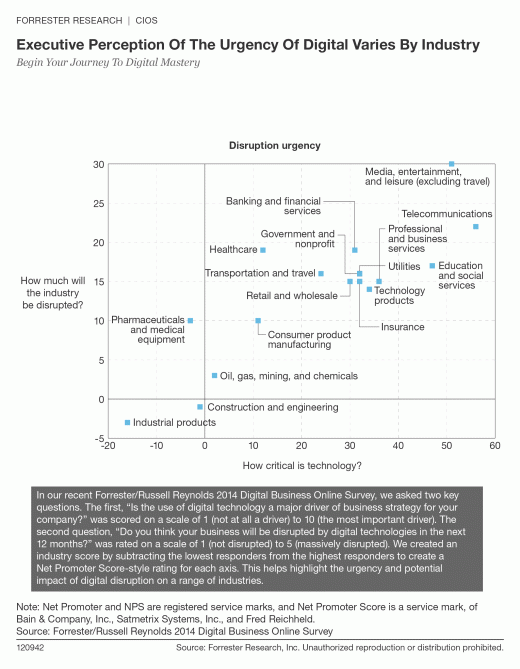
This article is part of a series written by speakers featuring at our upcoming tenth TNW Conference Europe. Martin is VP, Principal Analyst at Forrester Research. He focuses on eBusiness & Channel Strategy, and leads the development of Forrester’s Digital Business Transformation Playbook.
Yes, I said it. Most firms’ digital business transformations are doomed to failure.
Sure, they’ll deliver some stuff. Maybe some new apps or a fancy responsive design website — or even a digitally connected product so that they can proudly say they are part of the Internet of Things. But the reality is that most digital leaders won’t realize the full transformative potential of digital within their firms.
Here’s why (and what you need to do about it).
Leadership isn’t just the CEO’s job
Digital business transformation begins with a vision, but that vision doesn’t exist in isolation. It links an often vague corporate strategy to on-the-ground actions, such as replatforming websites or training employees. Almost a third of CEOs tell us that they personally set digital strategy. That’s got to be a good thing — the top dog in your organization personally taking responsibility for your digital strategy.
Well, perhaps not, as only 21 percent of executives say that their CEO sets a clear digital strategy. Terms like “multichannel,” “omnichannel,” and “digital” overlap when it comes to setting firms’ broad strategic direction and become unhelpful monikers that drive you to obsess over the question “Are we omnichannel?” rather than focusing on what your customers want from you. Take a look at eBay: It’s turning to design thinking to help it focus on the only thing that really matters — what its customers really want.
Digital is more than a bolt-on
Business leaders don’t think of digital as central to their business because, in the past, it hasn’t been. But now your customers, your products, your business operations, and your competitors are fundamentally digital.
While 74 percent of business executives say their company has a digital strategy, only 15 percent believe that their company has the skills and capabilities to execute on that strategy. A piecemeal strategy of bolting on digital channels or methods is no longer sufficient.
Stop thinking about creating a separate digital strategy and start thinking about how to digitize your business strategy. Look at firms like Airbnb and Uber: They’re designed for the digital age. Their business models are inherently mobile and social. They don’t just deliver great digital customer experiences; they strive for digital operational excellence and leverage extended ecosystems to achieve scale. But only 30 percent of executives think that digital will disrupt their line-of-business operations. Why? Because, for them, digital is apps and Apple Watches. They’re missing the true transformational opportunity that’s right in front of them.
Past technology mastery does not predict digital business success
Legacy technology management processes shackle your ability to change. You’re stuck with outdated project approval processes, design and development methodologies that demand pages of requirements that are almost immediately out of date before any code is even cut, and biannual release cycles that see you slide further and further behind your more nimble competitors.
Digital business forges a closer coupling between your business model, customer experience, and technology design than ever before; in response, you must transform how you go about designing, developing, and delivering your firm’s future platforms.
It’s not good enough to say, “We’re not a startup; we can’t do that.” Look to the firms that employ digital at massive scale for inspiration — like PayPal, Netflix, and Spotify — and challenge your own preconceptions. Although it might not look like it on the surface, many of these firms were shackled with legacy systems and thinking and have been through a similar transformation themselves. You face a cultural challenge, and just implementing some new technology isn’t the answer.
You think you know all the answers
The customer is always right. We’ve all heard that a million times. So why do so many executives assume that they personally have all the answers? Why do only 41 percent of firms actually measure metrics like Net Promoter Score and why do only 11 percent of firms robustly and systematically use those metrics to guide investment decisions?
Executives advocate their own pet projects, petitioning tech management to favor one set of interests over another, while technology teams base their decisions on vendor, legacy, or “coolness” factors. A combination of corporate arrogance, politics, and a lack of genuine customer insight hampers your firm’s agility. So when a bank learns to deliver rapid, customer-centric innovation, we can all learn something.
Spain’s CaixaBank uses open innovation to generate ideas, prioritizes innovations that deliver value to its customers, and gives digital teams the resources and autonomy to work on their own projects. The result? Systematic innovation and the continuous delivery of new or improved digital services to its customers.
Digital is rewriting the rules of business. For some industries, like media, it’s already happened. For others, like utilities or pharmaceuticals, it’s coming. Be under no illusion: No industry is immune (see the figure below). You need to figure out how soon it will hit you and what you need to do.

The good news is that at the most senior levels of most organizations, executive committees are acknowledging the combined opportunity and threat. The bad news is that most executive teams don’t really know what to do about it. At Forrester, we’ve seen a shift in the C-suite conversation over the past 18 months.
We used to get asked “Is digital disruption a threat to our business?” Now, the more common question is not even “What should we do?” but “How do we accelerate our pace of change?” That’s exactly what I’ll be talking about in my keynote speech at TNW Europe Conference. We’ve worked with dozens of organizations that are learning to crack the digital strategy code, and a common lesson is coming through loud and clear:
The way organizations have been planning and managing large-scale change is no longer fit for purpose
We need a new approach. An iterative, customer-centric, and agile approach. One in which your digital strategy is engaging, easily consumable by all your key stakeholders, compelling, and, above all, responsive to the inevitable change we all face.
Join me in Amsterdam to find out how.
Get the TNW newsletter
Get the most important tech news in your inbox each week.





